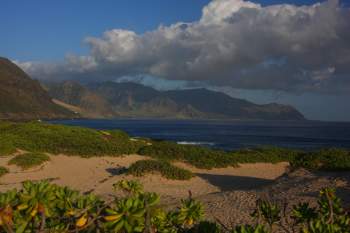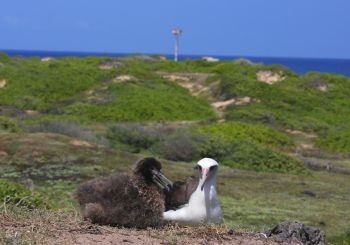The human population of the US island of Oahu in the State of Hawaii is approaching one million on an island of 1545 km2, a third of which lives within the city of Honolulu. Within 60 kilometres of this crowded metropolis locals and tourists alike may view breeding Laysan Albatrosses Phoebastria immutabilis within the open-access Ka'ena Point Natural Reserve Area at the westernmost tip of the island (click here and here). This locality is one of the very few in the World where breeding albatrosses may be seen by the general public without the need to join expensive wildlife expeditions to often out-of-the way places.

Laysan Albatrosses have attempted breeding at six sites on Oahu since 1979 and currently breed at two of them, as set out in a recent paper by Lindsay Young of Pacific Rim Conservation and several colleagues. Successful breeding is a more recent event, with the first chick fledging in 1992 once predator control was started. Population growth has come from immigration as well as from local recruitment and the annual breeding population of the island is now of the order of 75 pairs, having increased at the rate of 27% per year since 1991.
Efforts are underway to protect the largest colony, at Ka'ena Point, from introduced predators by the provision of a predator-proof fence, borrowing from successful New Zealand designs and due for erection during the course of this year (click here).
The paper postulates that the relatively-elevated breeding localities on Oahu for the Laysan Albatross, although small in comparison to those of the North-western Hawaiian Islands, may serve as a refuge in the event of sea level rise.

See also http://www.pacificrimconservation.com/PDF_Docs/66_Young_2009_Dissertation_final.pdf.
Reference:
Young, L.C., Vanderwerf, E.A., Smith, D.G., Polhemus, J., Swenson, N., Swenson, C., Liesemeyer, B.R., Gagne, B.H., & Conant, S. 2009. Demography and natural history of Laysan Albatross on Oahu, Hawaii. The Wilson Journal of Ornithology 121: 722-729. http://www.pacificrimconservation.com/PDF_Docs/64.pdf.
John Cooper, ACAP Information Officer and Lindsay Young, ACAP North Pacific News Correspondent, 23 March 2010

 Français
Français  English
English  Español
Español